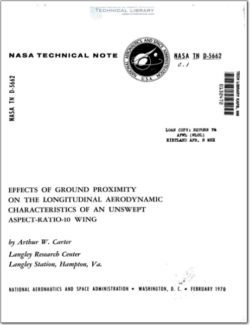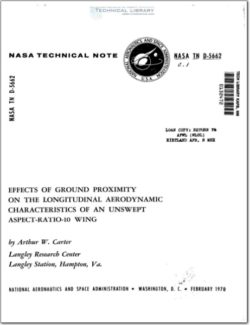NASA-TN-D-5662

- Version
- 211 Downloads
- 3.68 MB File Size
- 1 File Count
- November 27, 2015 Create Date
- November 27, 2015 Last Updated
Effect Of Ground Proximity On Long Characteristics On A AR10 Wing

A wind-tunnel investigation has been made of the effects of ground proximity on the
longitudinal aerodynamic characteristics of an unswept wing with an aspect ratio of 10
and a taper ratio of 0.3. Data were obtained over a stationary and moving—belt ground
plane with flaps retracted and with full—span double-slotted flaps deflected 300 and 50°.
Ground—effect data were also obtained for the model with leading-edge slats on the wing
with trailing-edge flaps deflected 50°. The results indicated the need for a moving—belt
ground plane in order to remove the boundary-layer buildup and to predict the correct
aerodynamic characteristics for a plain wing as well as for wings with trailing-edge flaps
and leading-edge slats.
With flaps retracted, the results indicated that a decrease in height of the wing above
the moving—belt ground plane produced an increase in the lift-curve slope, an increase in
the angle of attack for zero lift, and a decrease in the pitching—moment—curve slope.
With flaps deflected, the results indicated that a decrease in height of the wing above
the ground produced decreases in the maximum lift and in the negative or nose-down
pitching moments. The principal effect of ground proximity was a reduction in induced
drag which resulted in an increase in lift-drag ratios as the wing approached the ground.
The aerodynamic characteristics of a wing are influenced by the proximity of the
wing to the ground. Investigations of ground effects in wind tunnels normally are made
with a fixed ground plane placed in the airstream below the model to simulate the ground.
As pointed out in reference 1 for high-lift configurations at low heights above the ground,
the fixed ground plane provided incorrect simulation of the effects of ground proximity
because of the thick boundary layer which developed between the airstream and the ground
plane. Although this boundary layer has not created serious problems in investigations
of unpowered, low—lift configurations, the ground simulation is not strictly correct,
especially when the model is in close proximity to the ground. In order to provide an
accurate means of simulating the ground in wind-tunnel investigations, a moving-belt
ground plane was installed in the 17-foot (5.18—meter) test section of the Langley
300-MPH 7- by 10-foot tunnel as described in reference 2.
| File | Action |
|---|---|
| NASA-TN-D-5662-Effect-of-ground-proximity-on-long-characteristics-on-a-AR10-wing.pdf | Download |

Comment On This Post